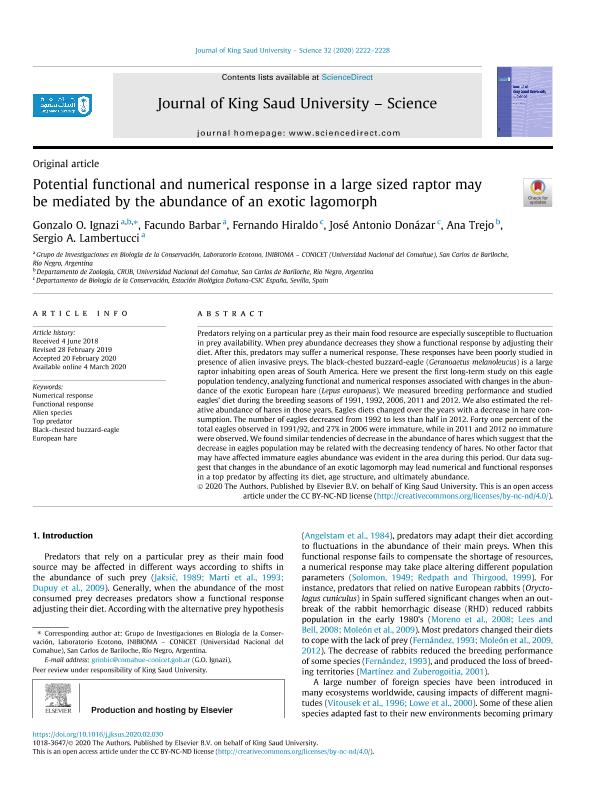Mostrar el registro sencillo del ítem
dc.contributor.author
Ignazi, Gonzalo Oscar

dc.contributor.author
Barbar, Facundo

dc.contributor.author
Hiraldo, Fernando

dc.contributor.author
Donázar, José Antonio
dc.contributor.author
Trejo, Ana Raquel

dc.contributor.author
Lambertucci, Sergio Agustin

dc.date.available
2020-07-02T20:47:09Z
dc.date.issued
2020-04
dc.identifier.citation
Ignazi, Gonzalo Oscar; Barbar, Facundo; Hiraldo, Fernando; Donázar, José Antonio; Trejo, Ana Raquel; et al.; Potential functional and numerical response in a large sized raptor may be mediated by the abundance of an exotic lagomorph; Elsevier; Journal of King Saud University - Science; 32; 3; 4-2020; 2222-2228
dc.identifier.issn
1018-3647
dc.identifier.uri
http://hdl.handle.net/11336/108717
dc.description.abstract
Predators relying on a particular prey as their main food resource are especially susceptible to fluctuation in prey availability. When prey abundance decreases they show a functional response by adjusting their diet. After this, predators may suffer a numerical response. These responses have been poorly studied in presence of alien invasive preys. The black-chested buzzard-eagle (Geranoaetus melanoleucus) is a large raptor inhabiting open areas of South America. Here we present the first long-term study on this eagle population tendency, analyzing functional and numerical responses associated with changes in the abundance of the exotic European hare (Lepus europaeus). We measured breeding performance and studied eagles? diet during the breeding seasons of 1991, 1992, 2006, 2011 and 2012. We also estimated the relative abundance of hares at each count site. Eagles diets changed over the years with a decrease in hare consumption. The number of eagles decreased from 1992 to less than half in 2012. Forty one percent of the total eagles observed in 1992/92, and 27% in 2006 were immature, while in 2011 and 2012 no immature were observed. We found similar tendencies of decrease in the abundance of hares which suggest that the decrease in eagles population may be related with the decreasing tendency of hares. No other factor that may have affected immature eagles abundance was evident in the area during this period. Our data suggest that changes in the abundance of an exotic lagomorph can lead numerical and functional responses in a top predator by affecting its diet, age structure, and ultimately abundance.
dc.format
application/pdf
dc.language.iso
eng
dc.publisher
Elsevier

dc.rights
info:eu-repo/semantics/openAccess
dc.rights.uri
https://creativecommons.org/licenses/by-nc-nd/2.5/ar/
dc.subject
FUNCTIONAL RESPONSE
dc.subject
NUMERICAL RESPONSE
dc.subject
EAGLE
dc.subject
HARE
dc.subject.classification
Ecología

dc.subject.classification
Ciencias Biológicas

dc.subject.classification
CIENCIAS NATURALES Y EXACTAS

dc.title
Potential functional and numerical response in a large sized raptor may be mediated by the abundance of an exotic lagomorph
dc.type
info:eu-repo/semantics/article
dc.type
info:ar-repo/semantics/artículo
dc.type
info:eu-repo/semantics/publishedVersion
dc.date.updated
2020-06-08T15:14:00Z
dc.identifier.eissn
2213-686X
dc.journal.volume
32
dc.journal.number
3
dc.journal.pagination
2222-2228
dc.journal.pais
Países Bajos

dc.journal.ciudad
Amsterdam
dc.description.fil
Fil: Ignazi, Gonzalo Oscar. Universidad Nacional del Comahue. Centro Regional Universidad Bariloche. Departamento de Zoología; Argentina. Universidad Nacional del Comahue. Centro Regional Universitario Bariloche. Laboratorio de Ecotono; Argentina. Consejo Nacional de Investigaciones Científicas y Técnicas. Centro Científico Tecnológico Conicet - Patagonia Norte. Instituto de Investigaciones en Biodiversidad y Medioambiente. Universidad Nacional del Comahue. Centro Regional Universidad Bariloche. Instituto de Investigaciones en Biodiversidad y Medioambiente; Argentina
dc.description.fil
Fil: Barbar, Facundo. Universidad Nacional del Comahue. Centro Regional Universitario Bariloche. Laboratorio de Ecotono; Argentina. Consejo Nacional de Investigaciones Científicas y Técnicas. Centro Científico Tecnológico Conicet - Patagonia Norte. Instituto de Investigaciones en Biodiversidad y Medioambiente. Universidad Nacional del Comahue. Centro Regional Universidad Bariloche. Instituto de Investigaciones en Biodiversidad y Medioambiente; Argentina. Universidad Nacional del Comahue. Centro Regional Universidad Bariloche. Departamento de Zoología; Argentina
dc.description.fil
Fil: Hiraldo, Fernando. Consejo Superior de Investigaciones Científicas. Estación Biológica de Doñana; España
dc.description.fil
Fil: Donázar, José Antonio. Consejo Superior de Investigaciones Científicas. Estación Biológica de Doñana; España
dc.description.fil
Fil: Trejo, Ana Raquel. Universidad Nacional del Comahue. Centro Regional Universidad Bariloche. Departamento de Zoología; Argentina
dc.description.fil
Fil: Lambertucci, Sergio Agustin. Consejo Nacional de Investigaciones Científicas y Técnicas. Centro Científico Tecnológico Conicet - Patagonia Norte. Instituto de Investigaciones en Biodiversidad y Medioambiente. Universidad Nacional del Comahue. Centro Regional Universidad Bariloche. Instituto de Investigaciones en Biodiversidad y Medioambiente; Argentina. Universidad Nacional del Comahue. Centro Regional Universitario Bariloche. Laboratorio de Ecotono; Argentina
dc.journal.title
Journal of King Saud University - Science
dc.relation.alternativeid
info:eu-repo/semantics/altIdentifier/url/https://www.sciencedirect.com/science/article/pii/S1018364720300872
dc.relation.alternativeid
info:eu-repo/semantics/altIdentifier/doi/http://dx.doi.org/10.1016/j.jksus.2020.02.030
Archivos asociados
